Laos
Population: 6,370,000
Capital: Vientiane
Time Zone: GMT +7
Part of 2006 World Trip, arriving from China and going on to Thailand.
Laos is truly beautiful country with a relaxed pace of life.
Use the navigation bar on the left or the map-links to select a place. Alternatively scroll down to see all the entries. Click on photos to enlarge. See all Laos photos here.
Laos is a lovely place, and my first experience was a fitting start to the rest of my journey here: sitting in the sun with a group of locals teaching them a little more English while they taught me some Lao. After quite a lot of explaining and gesturing I got some money changed and after a while I managed to get a bus across to the provincial centre - Luang Nam Tha.
Luang Nam Tha
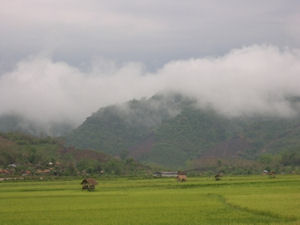
This is a truly rural part of the world, all roads are dirt tracks and the busses are crammed with people and bags of rice; as we slowly bounced along I looked out over never ending greenery. This is, for my, why it is such a beautiful country; it is so green and unspoiled. Luang Nam Tha, while being the regional centre would be defined in English terms as a small village. Tourism is still minimal here and carefully controlled, especially further into the forests were the indigenous villages are protected from prying groups of tourist.
On the bus I had met another guy called James and we set out to find a guesthouse and explore the town. James had spent the last few years living in Japan and so I was interested in all he had to say about living there. It also transpired that we had both been travelling the same route from Lijiang, where our paths had briefly crossed.
 After having a water-fight with the local girls next to our guesthouse - the Laos New Year celebrations continue for about a week - we had a spot of dinner. Here we met Joseph, an American now living in China. The three of us had similar outlooks on life and had some great conversations. James had with him the Japanese board game Go and Joseph had Chinese Chess, both games are fast and require a lot of thought, which I enjoyed, although sucked at.
After having a water-fight with the local girls next to our guesthouse - the Laos New Year celebrations continue for about a week - we had a spot of dinner. Here we met Joseph, an American now living in China. The three of us had similar outlooks on life and had some great conversations. James had with him the Japanese board game Go and Joseph had Chinese Chess, both games are fast and require a lot of thought, which I enjoyed, although sucked at. The Laos people are intimately connected to water. Most of the country is still more accessible by boat than road and the rivers also provide food and water to the communities. The lady running our guesthouse had clearly not lost her routes and seemed to spend much of the time showering or walking around wearing a towel. This was not unique as in every small village I travelled through at least some of the inhabitants would be seen bathing outside their houses regardless of the time of day.
The next morning I decided to head out and explore the surrounding area while the other two looked around the town. It had rained over night but looked clear so I hired a bicycle and set off. I travelled along tracks through rice fields and past small groups of houses, where the cries of 'hello' would always ring out for the children. This was great and I was having a great time until the rains hit again. For a while I sheltered under a tree but as the rain got heavier it looked like it would continue for a while.
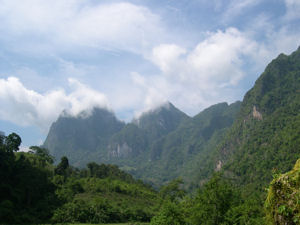 Within the next hour I perfected the art of mountain biking with an umbrella, not easy on bumpy mud tracks, and made it back for lunch just as the rain stopped. I met the others and spent the afternoon in a cafe, as we were walking back who should appear on a motorbike but the other James I had met in Jinghong - both James, it turned out, had been travelling together in China for some time. This is another reason why I like Laos so much, you always seem to bump into people you know. As will be apparent by now if you've read much of this diary that my travelling style is to decide where I am going and if others are travelling the same way to go with them. This means I often only travel with people for a day, sometimes an hour or at most a week. This I like because you have total freedom to do as you please and you meet lots of different and interesting people. In northern Laos especially this seems the norm and you continuously meet people you know, and the people you travel with are of a similar mind (and budget).
Within the next hour I perfected the art of mountain biking with an umbrella, not easy on bumpy mud tracks, and made it back for lunch just as the rain stopped. I met the others and spent the afternoon in a cafe, as we were walking back who should appear on a motorbike but the other James I had met in Jinghong - both James, it turned out, had been travelling together in China for some time. This is another reason why I like Laos so much, you always seem to bump into people you know. As will be apparent by now if you've read much of this diary that my travelling style is to decide where I am going and if others are travelling the same way to go with them. This means I often only travel with people for a day, sometimes an hour or at most a week. This I like because you have total freedom to do as you please and you meet lots of different and interesting people. In northern Laos especially this seems the norm and you continuously meet people you know, and the people you travel with are of a similar mind (and budget).The following day Joseph and myself caught a bus to the town of Nong Khiaw.
Nong Khiaw
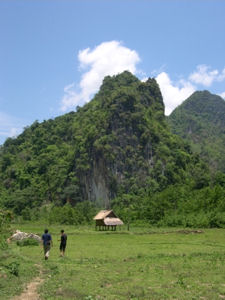 To get to Nong Khiaw from Luang Nam Tha the bus drops you at a small town and from here you have to get a second bus or a taxi. As in much of Laos, the locals know the tourist game and nearly everything operates in cartels to keep the price artificially high. While still cheap by western standards this can often be frustrating. And so Joseph, Alan, a Malaysian guy we had met on the bus, and I were confronted with a problem. There where three taxis - minivans with open backs - one owned by a young guy and the other two by older men. The first guy had quoted a price slightly less than the other 2 but had subsequently been told off and had revised the price to be inline with the others. Joseph, having lived in China for a few years, was well adept at the art of bartering and getting his own way. We thus sat in the back of the guys van with our stuff for an hour while they tried to make us pay the 'correct' price to which we would reply we would pay the agreed price. After something of a stalemate situation and another hour the older men left, straight away the young guy came over, we gave him a cigarette and he agreed to the lower price, such is life.
To get to Nong Khiaw from Luang Nam Tha the bus drops you at a small town and from here you have to get a second bus or a taxi. As in much of Laos, the locals know the tourist game and nearly everything operates in cartels to keep the price artificially high. While still cheap by western standards this can often be frustrating. And so Joseph, Alan, a Malaysian guy we had met on the bus, and I were confronted with a problem. There where three taxis - minivans with open backs - one owned by a young guy and the other two by older men. The first guy had quoted a price slightly less than the other 2 but had subsequently been told off and had revised the price to be inline with the others. Joseph, having lived in China for a few years, was well adept at the art of bartering and getting his own way. We thus sat in the back of the guys van with our stuff for an hour while they tried to make us pay the 'correct' price to which we would reply we would pay the agreed price. After something of a stalemate situation and another hour the older men left, straight away the young guy came over, we gave him a cigarette and he agreed to the lower price, such is life.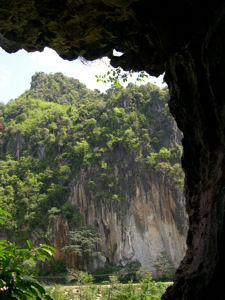
Nong Khiaw is at the limit of the Laos road network, and is a beautiful place surrounded by limestone cliffs. The following day the three of us set out to explore. Laos holds the dubious record of the most bombed country in the world. While not officially involved with the Vietnam War, the Americans thought the Viet Cong were running supplies through Laos and that it was imperative to stop the spread of communism to the rest of Asia. This, of course, was done by carpet-bombing the country for a good number of years. Just outside Nong Khiaw, hidden in the cliffs, is a set of caves used as a town hall, bank and barracks during this time. It is still possible to see bomb craters in the surrounding fields. We explored the caves for the morning then avoided the afternoon heat in a cafe. The following day I planned to head up river while the others took the bus to Luang Prabang.
Muang Ngoy
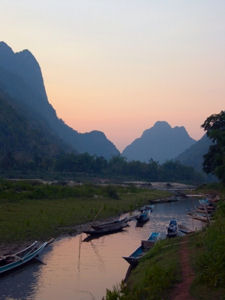 If Nong Khiaw was beautiful then it is hard to express Muang Ngoy. Only accessible by boat, this village is now something of a tourist spot - half the houses are guesthouses - but travelling during the hot season and not in the summer holidays has its perks and there were few westerners. I appreciate that I am also just a tourist, and like everyone else, I'm trying to find the less trodden path. Personally, I don't mind there being lots of tourist, as long as they are respectful of the locals and interesting to talk to - after all everyone basically want to go to the nicest places, and I enjoyed Muang Ngoi partly because of the other tourists I met there, what I dislike are the foreigners who have no regard for the local cultures and peoples, luckily there are few of these people in the places I have been. Because there were only a few of us, in the evenings we all gathered in one house and played cards by candlelight. The girl in charge of our hut, Wan, proudly informed us that they now had 24 hour electricity thanks to small turbines in the river. However, this was often insufficient even for lighting, and the village gets power a few hours a day from a generator. Muang Ngoy really represents the limit of tourism in Laos, from here it is possible to organise treks into the hills to see remote villages but there is no accommodation any further and the treks are limited, again to ovoid over exposing the villagers to foreigners. I have fairly strong views about 'seeing local people'. I feel that if it is unspoiled that I shouldn't poke my nose in. I prefer to meet the locals who wear jeans and t-shirt, are accustomed to westerners, and know about their country rather than those who, if you're cynical, wear jean and t-shirts then dress up for foreigners who want to see how life used to be - this is best done from a museum I feel.
If Nong Khiaw was beautiful then it is hard to express Muang Ngoy. Only accessible by boat, this village is now something of a tourist spot - half the houses are guesthouses - but travelling during the hot season and not in the summer holidays has its perks and there were few westerners. I appreciate that I am also just a tourist, and like everyone else, I'm trying to find the less trodden path. Personally, I don't mind there being lots of tourist, as long as they are respectful of the locals and interesting to talk to - after all everyone basically want to go to the nicest places, and I enjoyed Muang Ngoi partly because of the other tourists I met there, what I dislike are the foreigners who have no regard for the local cultures and peoples, luckily there are few of these people in the places I have been. Because there were only a few of us, in the evenings we all gathered in one house and played cards by candlelight. The girl in charge of our hut, Wan, proudly informed us that they now had 24 hour electricity thanks to small turbines in the river. However, this was often insufficient even for lighting, and the village gets power a few hours a day from a generator. Muang Ngoy really represents the limit of tourism in Laos, from here it is possible to organise treks into the hills to see remote villages but there is no accommodation any further and the treks are limited, again to ovoid over exposing the villagers to foreigners. I have fairly strong views about 'seeing local people'. I feel that if it is unspoiled that I shouldn't poke my nose in. I prefer to meet the locals who wear jeans and t-shirt, are accustomed to westerners, and know about their country rather than those who, if you're cynical, wear jean and t-shirts then dress up for foreigners who want to see how life used to be - this is best done from a museum I feel.
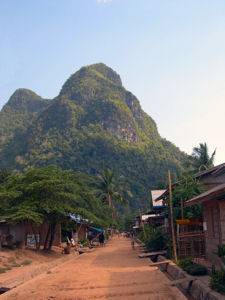
I spent a day walking in the forests. There was a large cave - I had brought my torch so had a quick explore but the main network requires a short dive through a submerged passage, which I wasn't up for. I saw lots of wildlife, although fortunately missed the leeches, which are quite prolific in the area. One of the most beautiful memories of Laos is the butterflies. For some reason large numbers are draw to small patches of ground, usually near the rivers or steams. When you walk near they all rise at once, filling the air around you with colour and movement, before all descending back on their little patch. The sunsets were also stunning, which seems rare for the tropics. I had been told that a fine journey to take was a boat all the way from Muang Ngoy to Luang Prabang. This was only possible if you chartered a boat, something that required money or people. Fortunately nearly everyone staying in the village though this was also a good idea, so after some organisation we were on our way. Boats are somewhat infrequent as they go for a price of about $100 (hence why you need quite a few people), and since we had arranged one, the local boat keeper subsequently sold a few extra tickets to a couple for foreigners much to our distaste.
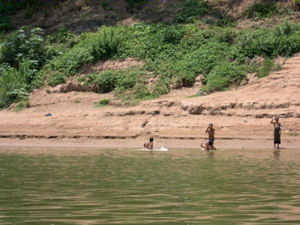
However, by chance, one of these guys was Paul who I had walked with in McLeodganj, which was a nice surprise, how small the world is. The boat journey took the best part of a day, travelling through the limestone cliffs, and past small villages. Without fail, children would be playing in the river and go mad when they saw the boat, jumping and waving and screaming 'Sabaai-dii' - hello.
Laung Prabang
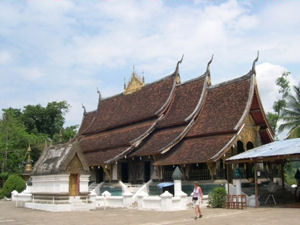 Laung Prabang is often referred to as the cultural capital of Laos. The town is situated on the banks of the Mekong River and boasts more temples than is possible to comprehend, all beautifully reconstructed after the Vietnam War. This was also something of a turning point in my journey, as Luang Prabang represents the further reaches of the Asian holidaymaker; from here my travels became consistently easier with the countries feeling a greater western influence. This took a little getting used to, and the sight of restaurants and young westerners was something of a culture shock for me.
Laung Prabang is often referred to as the cultural capital of Laos. The town is situated on the banks of the Mekong River and boasts more temples than is possible to comprehend, all beautifully reconstructed after the Vietnam War. This was also something of a turning point in my journey, as Luang Prabang represents the further reaches of the Asian holidaymaker; from here my travels became consistently easier with the countries feeling a greater western influence. This took a little getting used to, and the sight of restaurants and young westerners was something of a culture shock for me.I spent a couple of days wandering the temples then getting dinner with a German guy, Clements, who had also travelled down from Muang Ngoy. While previously the food had been fairly basic, here the French influence shows through and breakfasts were always warm baguettes with Lao coffee - rich coffee with lots of condensed milk making it very sweet.
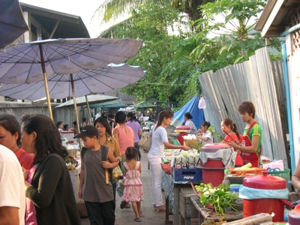
The street market was also interesting (picture) with many fruits and meets and again sold excellent baguette. I also tried one of the Luang Prabang specialities - buffalo skin in some sort of hot paste, 'interesting' and 'never again' are the only comments I can make. In the evenings we also enjoyed one of Laos most famous exports, Laos Beer, which is as good as the hype it receives.
On my penultimate day I ran into Alan and Joseph. It was particularly hot and humid that day so after coffee we decided to go for a swim in the river. We spent much of the afternoon swimming in the mini-rapids although did have to avoiding a dead dog that floated past. That evening I went to the night market and finally bought some lightweight fisherman trousers. I had been looking for something similar my whole trip as the heat and humidity is really too great for normal trousers or even shorts.
 Unfortunately I don't seem to have any photos of me in these tasteful baggy pink/purple (they started reddish in colour) hippy trousers, although I wore them almost continuously throughout the rest of Asia (they were so much cooler and more comfortable than shorts).
Unfortunately I don't seem to have any photos of me in these tasteful baggy pink/purple (they started reddish in colour) hippy trousers, although I wore them almost continuously throughout the rest of Asia (they were so much cooler and more comfortable than shorts).On my final day in Luang Prabang I got a bus out to some waterfalls a few miles from the town. I wasn't expecting much as I had seen some pretty good waterfalls in the Himalayas but these were stunning. Several large falls accompanied by some smaller ones. It was possible to swim in the pools but today there was light rain and actually not so warm - probably about 30 degrees but by now I was finally adjusting to the heat.
Vang Vieng
 I had heard several things about Vang Vieng, firstly it was picturesque, as to be expected in Laos, and second it was full of gap year students getting drunk and smoking hash and opium, this is also true to an extent. The others I had been with in Luang Prabang had chosen to avoid Vang Vieng. I, however, had a few days left on my visa and by now had made the conscious decision I was going to skip all of southern Laos, Thailand and most of Cambodia to give myself a good three weeks in Malaysia, which also gave me some extra free time.
I had heard several things about Vang Vieng, firstly it was picturesque, as to be expected in Laos, and second it was full of gap year students getting drunk and smoking hash and opium, this is also true to an extent. The others I had been with in Luang Prabang had chosen to avoid Vang Vieng. I, however, had a few days left on my visa and by now had made the conscious decision I was going to skip all of southern Laos, Thailand and most of Cambodia to give myself a good three weeks in Malaysia, which also gave me some extra free time.Vang Vieng is stunning. Situated on a small river and with massive limestone cliffs to the side, it is one of the most amazing views I seen. While the new town is full of bars that show Simpson's continuously, the old town is quite, although this could have something to do with the only road having just been removed (to be replaced). It was nice, however, to return to civilisation for a day or so and watch English television.
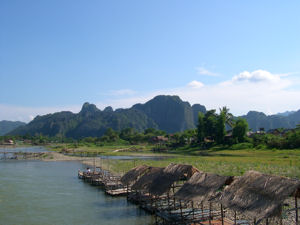 As soon as I had dumped my stuff in a guesthouse I set out into the hills. There are many caves - with guided tours, truly back in civilisation - but all of them were closed (and bolted shut!) as it was off-season. I found some woods and watched the formation of thunderclouds in the middle distance. When I returned I bumped in the two Dutch girls, both called Anna, who I had met in Muang Ngoy. One of the main attractions of Vang Vieng is to go tubeing on the river and the girls had just returned for a day of this. They showed me some photos and told me how to book.
As soon as I had dumped my stuff in a guesthouse I set out into the hills. There are many caves - with guided tours, truly back in civilisation - but all of them were closed (and bolted shut!) as it was off-season. I found some woods and watched the formation of thunderclouds in the middle distance. When I returned I bumped in the two Dutch girls, both called Anna, who I had met in Muang Ngoy. One of the main attractions of Vang Vieng is to go tubeing on the river and the girls had just returned for a day of this. They showed me some photos and told me how to book.The next morning I was up early to get to the tubeing station for the first bus out of town. I was with about 6 other people including 2 English guys and an American girl I had met on the bus the day before. We were taken a couple of miles upstream and given some large inner tubes and left to it. There isn't really much tubing to be done, the main attractions are next to the river, a number of bars and cafes along with large rope swings and aerial runways -
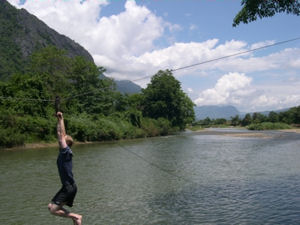 I only have a photo of the first runway which is very tame but the latter swings are about 20 meters up and almost straight plunges into the river beneath.
Between playing on the swings and sitting at the bars the day passes rather quickly. I had shared a dry bag with 2 of the others, and when they went on I had shared with the 2 English guys who I spent much of the day with. The last part of the trip, however, I got chatting with a Norwegian girl and lost the others. Bathed in the light of the setting sun the shear cliffs on either side of the river were beautiful, however after this it was quickly too dark to see anything and we had to get a taxi. Unfortunately, this meant that by the end of the day I had misplaced my camera, wallet, room key, sunscreen and perhaps most importantly my hat. In my life things tend to work out, given enough patience and effort, so later that evening (after the son of the guesthouse owner trying every key they had, and a conversation about drilling out the lock) I managed to find regain my keys and camera. The following day I also found my wallet and hat. However my sunscreen never reappeared. Worst perhaps of all, the torrential rain of the afternoon combined with a somewhat inadequate dry bag left my camera in a dismal state, from which it never worked again.
I only have a photo of the first runway which is very tame but the latter swings are about 20 meters up and almost straight plunges into the river beneath.
Between playing on the swings and sitting at the bars the day passes rather quickly. I had shared a dry bag with 2 of the others, and when they went on I had shared with the 2 English guys who I spent much of the day with. The last part of the trip, however, I got chatting with a Norwegian girl and lost the others. Bathed in the light of the setting sun the shear cliffs on either side of the river were beautiful, however after this it was quickly too dark to see anything and we had to get a taxi. Unfortunately, this meant that by the end of the day I had misplaced my camera, wallet, room key, sunscreen and perhaps most importantly my hat. In my life things tend to work out, given enough patience and effort, so later that evening (after the son of the guesthouse owner trying every key they had, and a conversation about drilling out the lock) I managed to find regain my keys and camera. The following day I also found my wallet and hat. However my sunscreen never reappeared. Worst perhaps of all, the torrential rain of the afternoon combined with a somewhat inadequate dry bag left my camera in a dismal state, from which it never worked again.You can only have so much excitement so after something of a rest day I headed on to the Laos capital, Vientiane.
Vientiane
There is not a great deal to say about Vientiane. There is a nice temple complex, Thatluang, which houses a golden temple and there is a copy of the arc de triumph - made from concrete donated by the US to build an airport. It also rained the whole day I arrived, not putting anything in its best light. However, my visa only allowed me to stay one day so the next morning I set out cross the border into Thailand.